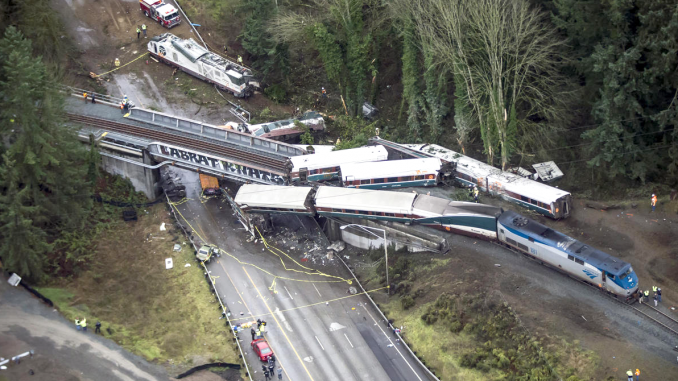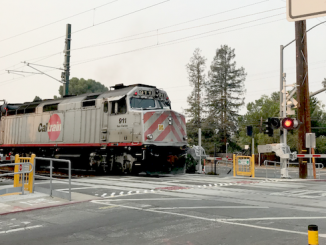
From staff and wire reports
The rush to launch service on a new, faster Amtrak route near Seattle came at a deadly cost: none of the critical speed-control technology that could have prevented a derailment was active before the train set off on its maiden voyage.
Work to install the sophisticated, GPS-based technology known as positive train control, or PTC, isn’t expected to be completed on the newly opened 15-mile span where the train derailed until next spring, according to Sound Transit, the public agency that owns the tracks.
PTC was supposed to have been installed along the Caltrain line by 2015, but the commuter railroad has repeatedly missed deadlines. Caltrain hopes to have the $231 million system installed by December 2018, a federal deadline.
In Dupont, Wash., the train was going 80 mph in a 30 mph zone Monday when it raced off the rails as they curved toward a bridge, hurtling train cars onto a highway below, investigators said. Three people were killed, and dozens were injured. Federal investigators say they are looking into whether the engineer was distracted.
PTC to be required in one year
PTC could have detected the speeding and automatically applied the brakes to stop the train, said Najmedin Meshkati, a USC professor who has studied the technology for three decades.
“It is another layer of safety,” he said.
Amtrak and the Washington Department of Transportation started publicizing the switch to the new route in October. The agencies did not immediately respond to questions about why they did so while the speed-control technology was still months away.
Railroads are under government orders to install positive train control by the end of 2018 after the industry lobbied Congress to extend earlier deadlines, citing complexity and cost.
Caltrain’s PTC project
Locally, Caltrain’s PTC installation fell behind because of miscommunication between the railroad and its contractor, Parsons Transportation Group. Caltrain fired Parsons in February. The two entities are now suing each other in San Mateo County Superior Court.
Caltrain claims it had to fire Parsons because of repeated delays. Parsons said it was delayed because of changes made by Caltrain, a lack of access to the tracks, inaccurate data in Caltrain’s files, and late responses by Caltrain for information necessary to finish the job.
Parsons claims it has incurred more than $35 million in losses due to Caltrain’s delays and changes. Caltrain is suing Parsons for $98 million.
While the Caltrain PTC installation isn’t going well, Union Pacific, the nation’s largest freight carrier, said it was spending $2.9 billion on the technology. Industry groups estimate railroads will spend a total of about $10 billion to install and implement the systems.
Monday’s wreck is just the latest example of a deadly crash that experts say could have been prevented if the technology were in place to slow down the train when engineers go too fast, get distracted or fall ill.
U.S. investigators have listed a lack of such a system as a contributing factor in at least 25 crashes over the last 20 years, including two in the last four years where a train approached sharp curves at more than double the speed limit.
A Metro-North train crashed in New York City in 2013, killing four people, when an engineer with sleep apnea dozed off. An Amtrak train crashed in Philadelphia in 2015, killing eight people, when investigators say the engineer was distracted by radio traffic and lost his bearings.
Positive train control was installed on 23% of the nation’s passenger route miles and 37% of freight route miles as of July, the last time the Federal Railroad Administration updated its online tracker for the technology.
The National Transportation Safety Board first recommended the use of “automatic train control” in 1970, a year after two Penn Central commuter trains collided, killing four and injuring 43.
The railroad industry was opposed for decades until a Metrolink commuter train collided head-on with a freight train near Los Angeles in 2008. Investigators said the train’s engineer was texting and ran a stop signal, killing 25 people.
“It’s a good fail-safe for human error,” said Fran Kelly, assistant general manager for SEPTA, the Philadelphia-area commuter railroad that was an early adopter of positive train control. “It’s using the best technologies available to complement what the human engineer is doing — the human element of it.”



